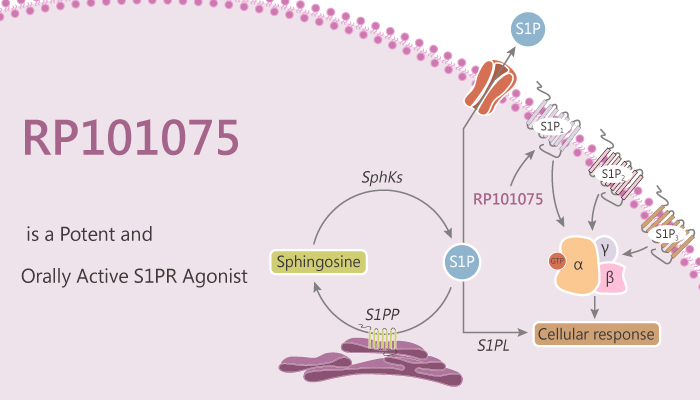Sphingosine-1-phosphate (S1P) is a ligand for G-protein-coupled receptors, it is responsible for some cell-intrinsic and extrinsic activities. RPC1063 is a potent and selective S1PR1 modulator. It emerges as a new option for immune intervention. Besides, it has efficacy and safety in relapsing-remitting MS and inflammatory bowel disease. Intracerebral hemorrhage (ICH) is a devastating stroke with high mortality and morbidity.
Accumulating evidence proves that brain inflammation may due to the microglia and infiltrating lymphocytes, especially ICH-induced brain injury. RP101075, an active metabolite of Ozanimod. Additionally, it has a high steady-state brain: blood ratio in the previous study. As a result, RP101075 is applied in the ICH treatment study.
RP101075 is a potent, orally active S1PR (sphingosine-1-phosphate receptor 1) agonist, with an EC50 of 0.27 nM. Additionally, it displays >100-fold selectivity over S1PR5 (EC50=5.9 nM) and >10000-fold over S1PR 2, 3, and 4.

RP101075 displays a superior cardiovascular safety profile. In intracerebral hemorrhage (ICH) mice, RP101075 significantly attenuates neurological deficits and reduces brain edema. Furthermore, it reduces the counts of brain-infiltrating lymphocytes, neutrophils, and microglia, as well as cytokine expression after ICH. After RP101075 treatment, enhanced blood-brain barrier integrity and alleviated neuronal death are also seen in ICH mice.
As a specific and potent small molecule modulator of S1PR1 and S1P receptor 5, RPC1063 exhibits therapeutically beneficial in relapsing MS and ulcerative colitis. Nextly, in the NZBWF1 murine SLE model, RP101075 inhibits lymphocytes and pDC in the spleens of mice. Whatmore, RP101075 leads to a dose-dependent reduction in lymphocytes in the spleen following 20 weeks of treatment; as well as a reduction in plasmacytoid dendritic cells (pDC).
Whatmore, RP-101075 significantly inhibits expression of genes encoding pro-fibrotic proteins such as TGF-β, Transgelin, lipocalin, TIMP1, and LOXL1. It also suppressed the expression of genes encoding pro-inflammatory proteins such as IL-1β, CCL5, and CXCL9.
In conclusion, RP-101075 is efficacious in ICH or NZBWF1 SLE mouse model. And it is important to explore the function of both ozanimod and its metabolite RP-101075 in S1PR1, R5 pathway during the development of the disease.
Reference:
[1]. Sun N, et al. Stroke. 2016;47(7):1899-1906.
[2]. Taylor Meadows KR, et al. PLoS One. 2018;13(4):e0193236. Published 2018 Apr 2.